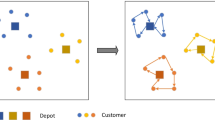Abstract
A practical variant of the vehicle routing problem (VRP), with simultaneous delivery and pickup and time windows (VRPSDPTW) is a challenging combinatorial optimization problem that has five optimization objectives in transportation and distribution logistics. Chemical reaction optimization has been used to solve mono and multi-objective problems. However, almost all attempts to solve multi-objective problems have included continues problems less than four objectives. This paper studies discrete multi-objective VRPSDPTW using decomposition-based multi-objective optimization chemical reaction optimization. In the proposed algorithm, each decomposed sub-problem is represented by a chemical molecule. All of the molecules are divided into a few groups, with each molecule having several neighboring molecules. To balance the diversity and convergence, we designed operators of on-wall ineffective collision and inter-molecular ineffective collision for a local search, as well as operators of decomposition and synthesis to enhance global convergence. The proposed approach is compared with two different algorithms on hypervolume performance measures. Experimental results show that the proposed algorithm outperform the other algorithms in most benchmarks.









Similar content being viewed by others
References
Goldbarg MC, Asconavieta PH, Goldbarg EFG (2012) Memetic algorithm for the traveling car renter problem: an experimental investigation. Memet Comput 4(2):89–108
Xu Y, Lim MH, Ong YS (2008) Automatic configuration of metaheuristic algorithms for complex combinatorial optimization problems. In: 2008 IEEE Congress on Evolutionary Computation (IEEE World Congress on Computational Intelligence). IEEE, pp 2380–2387
Földesi P, Botzheim J (2010) Modeling of loss aversion in solving fuzzy road transport traveling salesman problem using eugenic bacterial memetic algorithm. Memet Comput 2(4):259–271
Wang C, Mu D, Zhao F et al (2015) A parallel simulated annealing method for the vehicle routing problem with simultaneous pickup–delivery and time windows. Comput Ind Eng 83:111–122
Cherkesly M, Desaulniers G, Laporte G (2015) A population-based metaheuristic for the pickup and delivery problem with time windows and LIFO loading. Comput Oper Res 62:23–35
Tan KC, Chew YH, Lee LH (2006) A hybrid multiobjective evolutionary algorithm for solving vehicle routing problem with time windows. Comput Optim Appl 34(1):115–151
Wang J, Zhou Y, Wang Y et al (2016) Multiobjective vehicle routing problems with simultaneous delivery and pickup and time windows: formulation, instances, and algorithms IEEE Trans Cybern 46(3):582–594. doi:10.1109/TCYB.2015.2409837
Hsu WH, Chiang TCA (2012) Multiobjective evolutionary algorithm with enhanced reproduction operators for the vehicle routing problem with time windows. In: IEEE Congress on Evolutionary Computation (CEC). IEEE, pp 1–8
Iqbal S, Kaykobad M, Rahman MS (2015) Solving the multi-objective vehicle routing problem with soft time windows with the help of bees. Swarm Evol Comput 24:50–64
Li H, Landa-Silva D (2011) An adaptive evolutionary multi-objective approach based on simulated annealing. Evol Comput 19(4):561–595
Zhang Q, Li H (2007) MOEA/D: a multi-objective evolutionary algorithm based on decomposition. IEEE Trans Evol Comput 11(6):712–731
Gong M, Cai Q, Chen X et al (2014) Complex network clustering by multiobjective discrete particle swarm optimization based on decomposition. IEEE Trans Evol Comput 18(1):82–97
Qi Y, Hou Z, Li H et al (2015) A decomposition based memetic algorithm for multi-objective vehicle routing problem with time windows. Comput Oper Res 62:61–77
Lam AYS, Li VOK (2012) Chemical reaction optimization: a tutorial. Memet Comput 4(1):3–17
Xu J, Lam A, Li VOK (2011) Chemical reaction optimization for task scheduling in grid computing. IEEE Trans Parallel Distrib Syst 22(10):1624–1631
Duan H, Gan L (2015) Orthogonal multiobjective chemical reaction optimization approach for the brushless DC motor design. IEEE Trans Magn 51(1):1–7
Bechikh S, Chaabani A, Said L (2015) An efficient chemical reaction optimization algorithm for multiobjective optimization. IEEE Trans Cybern 45(10):2051–2064
Li H, Wang L, Hei X (2015) Decomposition-based chemical reaction optimization (CRO) and an extended CRO algorithms for multiobjective optimization. J Comput Sci. doi:10.1016/j.jocs.2015.09.003
Ishibuchi H, Akedo N, Nojima Y (2015) Behavior of multiobjective evolutionary algorithms on many-objective knapsack problems. IEEE Trans Evol Comput 19(2):264–283
Das I, Dennis JE (1998) Normal-boundary intersection: a new method for generating the Pareto surface in nonlinear multicriteria optimization problems. SIAM J Optim 8(3):631–657
Liu HL, Gu F, Cheung Y (2010) T-MOEA/D: MOEA/D with objective transform in multi-objective problems. In: 2010 international conference of information science and management engineering (ISME), vol 2. IEEE, pp 282–285
Zhang X, Tian Y, Jin Y (2015) A knee point-driven evolutionary algorithm for many-objective optimization. IEEE Trans Evol Comput 19(6):761–776
Zitzler E, Multiobjective Thiele L (1999) Evolutionary algorithms: a comparative case study and the strength Pareto approach. IEEE Trans Evol Comput 3(4):257–271
Wilcoxon F (1945) Individual comparisons by ranking methods. Biom Bull 1(6):80–83
Acknowledgements
The authors would also like to thank Prof. J. Wang for providing the 45 MOVRPTW Instances, Prof. H. L. Liu for providing the source codes of TMOEA/D. This work is partially supported by National Natural Science Foundation of China (Nos. U1534208, 61272283, U1334211), Shaanxi Science and Technology Innovation Project (2015KTZDGY01-04).
Author information
Authors and Affiliations
Corresponding author
Rights and permissions
About this article
Cite this article
Li, H., Wang, L., Hei, X. et al. A decomposition-based chemical reaction optimization for multi-objective vehicle routing problem for simultaneous delivery and pickup with time windows. Memetic Comp. 10, 103–120 (2018). https://doi.org/10.1007/s12293-016-0222-1
Received:
Accepted:
Published:
Issue Date:
DOI: https://doi.org/10.1007/s12293-016-0222-1




